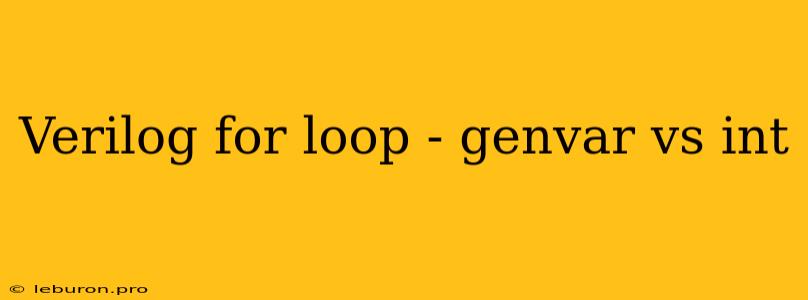Verilog is a hardware description language (HDL) widely used in the design and verification of digital circuits. It provides constructs for defining hardware components and their behavior. One of the crucial aspects of Verilog is the ability to create repetitive structures using loops. This article delves into the nuances of Verilog for loops, specifically focusing on the difference between genvar and int variables within the loop context. Understanding this distinction is crucial for achieving efficient and synthesizable code.
Understanding Verilog For Loops
For loops in Verilog serve as powerful tools for generating repetitive hardware structures. They offer a concise way to define modules, instances, and connections based on predefined patterns. However, the way variables are handled within these loops has implications for their synthesis and the resulting hardware architecture.
The Role of Genvar
Genvar is a special type of variable in Verilog that is designed specifically for use within generate statements. It is not a regular variable that can be assigned values directly within a procedural block like an always block. Instead, genvar acts as an index variable within the generate statement, influencing how instances of modules or other constructs are generated.
Genvar variables are implicitly declared and have a range of values determined by the for loop's control parameters. Unlike int variables, they cannot be used for general computations or assignments within procedural blocks. Their primary purpose is to manage the iteration of the generate block.
The Int Variable: A General-Purpose Counter
In contrast to genvar, int variables are general-purpose integer variables. They can be declared and used within any procedural block, including always blocks. Unlike genvar, int variables can be assigned values dynamically, including within the for loop itself.
Int variables can be utilized for various purposes, such as counting events, performing arithmetic operations, or storing temporary data. However, it's important to understand that int variables are not directly tied to the generation of hardware instances. They are essentially temporary variables whose values are typically reset at the start of each clock cycle.
The Key Differences Between Genvar and Int
Understanding the fundamental distinctions between genvar and int variables is crucial for writing efficient and synthesizable Verilog code. Let's explore these differences in detail:
-
Scope and Usage:
- Genvar: Genvar variables are restricted to generate statements. They are primarily used for iterating over instances within a generate block and have no meaning outside that context.
- Int: Int variables are general-purpose and can be declared and used within any procedural block. They are typically used for internal computations and data storage within a given process or module.
-
Dynamic Assignment:
- Genvar: Genvar variables cannot be dynamically assigned values within procedural blocks like always blocks. Their values are implicitly determined by the for loop's range.
- Int: Int variables can be assigned values dynamically within procedural blocks, including within the for loop itself. This allows for flexible computation and data manipulation.
-
Synthesis and Hardware Mapping:
- Genvar: Genvar variables directly influence the generation of hardware instances. Each iteration of a generate block with a genvar variable results in the instantiation of a new hardware module or component.
- Int: Int variables typically do not result in the generation of new hardware. They are often associated with temporary computations or data storage within a given process or module.
-
Reusability:
- Genvar: Genvar variables are tied to the specific generate block where they are declared. They cannot be reused across different modules or blocks.
- Int: Int variables are reusable across different modules or blocks. They can be declared and used in various contexts within a Verilog design.
Practical Example: Genvar for Instantiation
Let's consider an example to illustrate the use of genvar for instantiating multiple instances of a module. Imagine we want to create a simple array of N registers.
module register_array (
input clk,
input reset,
input [N-1:0] data_in,
output [N-1:0] data_out
);
genvar i;
generate
for (i = 0; i < N; i = i + 1) begin
register #(8) reg_inst (
.clk(clk),
.reset(reset),
.data_in(data_in[i]),
.data_out(data_out[i])
);
end
endgenerate
endmodule
In this example, the genvar variable i is used to iterate through N instances of the register module. Each iteration creates a unique instance of the module, connected to the appropriate input and output signals using the i index.
Example: Int for Data Processing
Now, let's see how int variables can be used for data processing within an always block:
module data_processing (
input clk,
input reset,
input [7:0] data_in,
output [7:0] data_out
);
reg [7:0] data_buffer;
int count;
always @(posedge clk) begin
if (reset) begin
data_buffer <= 0;
count <= 0;
end else begin
for (count = 0; count < 4; count = count + 1) begin
data_buffer <= data_buffer + data_in;
end
data_out <= data_buffer;
end
end
endmodule
Here, the int variable count is used to control a loop that adds data_in to data_buffer four times. This loop executes within an always block, making count a temporary variable that is reset at the start of each clock cycle. The loop does not generate any hardware instances; it simply performs a sequence of operations within the always block.
Synthesis Implications
It's important to understand that genvar variables are specifically designed for synthesis and hardware instantiation. Their use within generate blocks results in the creation of dedicated hardware modules or components. On the other hand, int variables are typically treated as temporary variables that are synthesized into internal logic within a process. They do not directly map to dedicated hardware blocks.
Conclusion
The distinction between genvar and int variables in Verilog for loops is crucial for achieving efficient and synthesizable hardware designs. Genvar variables are designed for the generation of hardware instances, while int variables are general-purpose variables used for computations and data manipulation within processes. Understanding these differences and their implications for synthesis is vital for writing robust and predictable Verilog code. Choosing the appropriate type of variable based on the intended use is crucial for generating accurate and efficient hardware.
